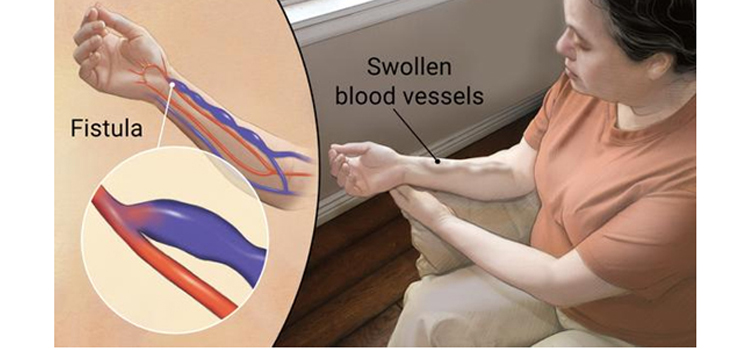Menu
Dialysis or vascular access is a hemodialysis patient’s lifeline because it makes
life-saving hemodialysis treatments possible. Hemodialysis is a treatment for kidney failure that uses a machine to remove waste products from a patient’s blood. Dialysis access lets large amounts of blood flow continuously during hemodialysis treatments to filter as much blood as possible per treatment. Dialysis access should be in place weeks or months before the first hemodialysis treatment.
Two types of dialysis access designed for long-term use include the arteriovenous (AV) fistula and the AV graft. The third type of dialysis access—the dialysis catheter—is for short-term use.
An AV fistula is a connection, made by a vascular surgeon, of an artery to a vein.
Arteries carry blood from the heart to the body, while veins carry blood from the body
back to the heart. Vascular surgeons specialize in blood vessel surgery. The surgeon
usually places an AV fistula in the forearm or upper arm. An AV fistula causes extra
pressure and extra blood to flow into the vein, making it grow large and strong. The larger vein provides easy, reliable access to blood vessels.

Nephrologists & other health care providers recommend an AV fistula over the other types of access because it
A vascular surgeon performs AV fistula surgery in an outpatient center or a hospital.
This procedure may require an overnight stay in the hospital; however, many patients
go home afterward. Majority of time AV fistula can be done under local anesthesia
only.
An AV fistula frequently requires 2 to 3 months to develop, or mature, before the
patient can use it for hemodialysis.
An AV graft is a plastic tube that connects an artery to a vein. A vascular surgeon
performs AV graft surgery, much like AV fistula surgery, when suitable veins are not
available for AV fistula craetion.
A patient can usually use an AV graft 2 to 3 weeks after the surgery. An AV graft is
more likely than an AV fistula to have problems with infection and clotting. Repeated
blood clots can block the flow of blood through the graft. However, a well-cared-for
graft can last several years.

A dialysis catheter is a tube inserted into a vein in the neck, chest, or leg near the
groin, usually only for short-term hemodialysis. If kidney disease has progressed
quickly, a patient may not have time for placement of an AV fistula or AV graft
before starting hemodialysis treatments and dialysis catheters are used in such kinds of
patients.
Dialysis catheters are not ideal for long-term use. With a dialysis catheter, a patient
may develop a blood clot, an infection, or a scarred vein, causing the vein to narrow.
However, if a patient needs to start hemodialysis right away, a dialysis catheter will
work for several weeks or months until a long-term access surgery and the AV fistula
or AV graft has time to mature.
If fistula or graft surgery is unsuccessful, then a patient will need a long-term dialysis
catheter access. When a patient needs a dialysis catheter for more than 3 weeks, the
surgeon will “tunnel” the catheter under the skin, rather than insert it directly into the
vein. A tunneled catheter is more comfortable and has fewer problems. Even tunneled
catheters, however, may become infected.
Sometimes, after using AV fistula or AV graft for many years, it can give problem to
the patient. Due to repeated punctures for hemodialysis, AV fistula vein can become
narrow and it can give rise to problems during dialysis like
All these patients require proper evaluation of AV fistula or AV graft and if requires it
can be treated with angioplasty and with this same dialysis access can be used for
many years. If dialysis patients are having any of above symptoms, they should meet
vascular surgeon for further assessment and treatment.